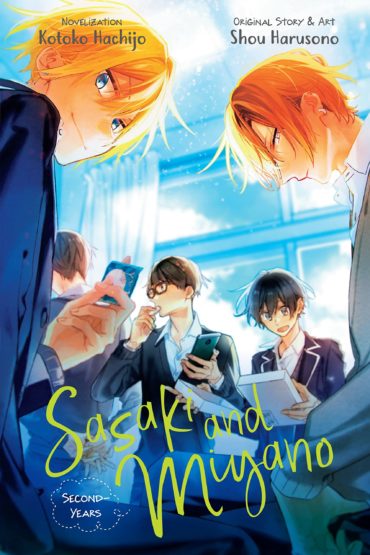Sasaki and Miyano Second-Years Review
“Have Yuki and Miyano given me a case of BL brain?” Kuresawa, reflecting on the influence of his girlfriend and his best friend.
Now that Miyano, Kuresawa and Tashiro are second-years in high school, they get to go on a school trip in the autumn and after consulting their friends in the third year, the vote is to visit Hokkaido for five days, starting in Sapporo. We follow their adventures away from home, as they try their hands at making ice cream (even Miyano!) and go up Mount Moiwa on a cable car. And, of course, there’s the inevitable chatting after lights out at the hotel (pity the poor teachers on night patrol duty) followed by the obligatory buying of souvenirs for family and friends back home. When Kuresawa is in a Hakodate gift shop looking for a suitable present for his girlfriend, he can’t help overhearing the conversation of two boys from another class, one of them tall and muscled like a sports player. Why are they talking about earrings? Who are they – or rather the tall one – choosing for? (There’s enough hints here for readers familiar with the series to have guessed already – but if not, there’s a helpful drawing from creator Shou Harusono, making all clear.)
After the school trip, there’s a time skip to the following March as Miyano (not the world’s greatest cook) joins Kuresawa, Tashiro and Kagiura’s friend Niibashi in making cookies at school to give for White Day. Chapter 4 follows Miyano as he calls at Sasaki’s house to give him his home-made White Day present – and the final chapter focuses on third-years Sasaki and Hirano as they come to the end of their time in high school. The rest of the slim volume is a bonus comic by the mangaka herself, reminding us (as do the full-page illustrations) that when it comes to portraying these characters and their interactions, she’s the one who knows best how to do it.
If you’re a fan of Sasaki and Miyano the manga, you’re almost certainly also a fan of Kuresawa, Miyano’s earnest, glasses-wearing classmate who’s obsessed with his girlfriend Yuki. We got to meet Yuki in the first volume of this spin-off light novel series and here, the first chapter is again all about the two of them spending time together. But, happily, she’s no longer in hospital, so he’s visiting her at home. In many ways, the Kuresawa-narrated chapters are the best in the volume (again) as they’re presenting new material to the manga-reader. Whereas when we get to spend time with Miyano and Sasaki in prose fiction, things aren’t always so convincing, even when it’s a first-person Sasaki narrative.
One of my problems with the Japanese light novel in translation is the use of language and the writing style such as over-dependance on dialogue, punctuated by the occasional awkward descriptions of the characters gesturing, smirking, etc. Kotoko Hachijo’s earlier novelisations: Hirano and Kagiura and Sasaki and Miyano: First Years flow relatively well, without displaying many of the above issues but here, unfortunately, I came up against some in what is effectively the scene many fans have been eagerly waiting for: Miyano in Sasaki’s house. Just the two of them. Alone together. Written with care and sensitivity, a love scene (even one that isn’t in any way explicit, and given the 13+ rating, this one isn’t) should be convincing and not rudely break the spell by employing unexpected word choices. Yet here I came across two instances of use of language that threw me right out of the scene. Was the author responsible – or the translator? In the first case it’s definitely the author – and what a strange choice she’s made to enhance the romantic atmosphere at a crucial moment.
‘“Sasaki?” there was a touch of panic in his voice. His Adam’s apple bobbed dramatically but he didn’t say anything else.’
‘Adam’s apple’ reinforces the fact that Miyano is male, I suppose, in case readers had forgotten. We’ve been looking at him (fondly) from Sasaki’s viewpoint – but suddenly it feels omniscient and it throws the reader right out of the scene. It’s also not an appealing image. Things improve after that until at the very end of the chapter:
“Can I kiss you? Just once or twice?”
“Hah! I’ve heard that line before.” Miyano snickered, and then he closed his eyes.
The dictionary definition for ‘snicker’ is: ‘give a half-suppressed, typically scornful laugh. Synonyms: snigger, sneer, smirk, simper, titter, giggle, chortle’. None of these would have been a great choice, to be honest, in the context and it’s very possible that the translator was left with nowhere else to go. But it’s a real pity that this highly anticipated chapter is unable to sustain the intimate atmosphere as it has its sensual moments.
The translation for the Yen On edition is again by Kevin Steinbach and the volume has two pages of Shou Harusono’s colour art at the beginning, as well as her striking cover art with its photo-style glimpses of high school life. Both novelization author Kotoko Hachijo and mangaka Shou Harusono have an ‘Afterword’ page at the end, including explaining where each story comes in relation to the manga chapters, which is helpful.
So, if you’ve been following Sasaki and Miyano, this is a must-read; you’ve probably already bought your copy! If you’re a newcomer, then this is definitely not the place to start; it’s best to pick up the manga from the beginning – or the TV anime series as it’s a very faithful and likable adaptation.
Our review copy from Yen Press was supplied by Diamond Book Distributors UK.


